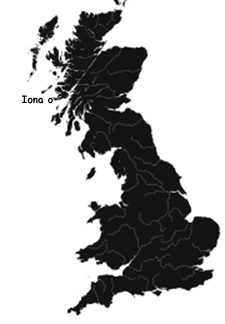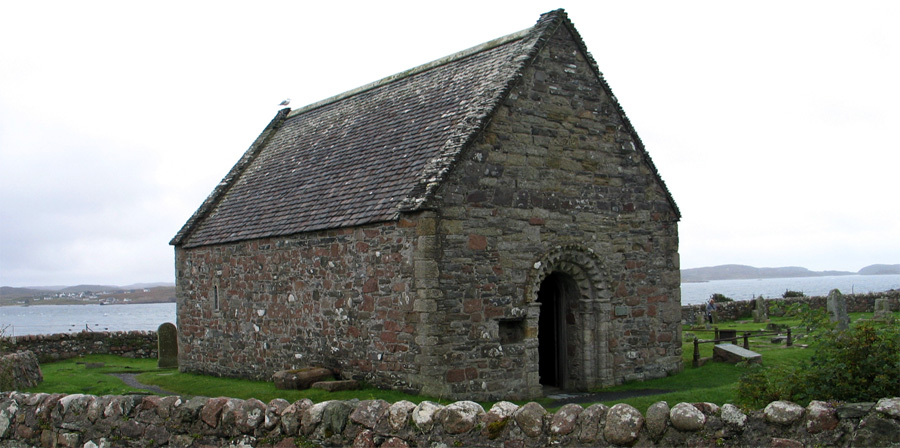 In 563 A.D., St. Columba (Columcille) and 12 companions founded the monastery of Iona. It became a renowned monastic school of learning and was mainly responsible for the spread of Christianity throughout much of Scotland and northern England. It was here, it is believed, that the Book of Kells, one of the most famous illuminated manuscripts and now residing at Trinity College in Dublin, was produced in whole or in part. After a series of Viking raids, the monastery was eventually abandoned in the 9th Century. In the early 12th Century, the present abbey and a nunnery were erected to house Benedictine monks and Augustinian nuns. They continued to flourish until the Reformation and fell into ruin. The abbey and many of the other monastic buildings, which may be visited today, were laregly renovated in the 20th Century The nunnery has been left in its ruined stage.
The oldest building still standing on Iona is easy to overlook as you approach the island's magnificent abbey. St. Oran's Chapel is a small stone building set within a walled graveyard that you pass on your right just before you reach the gateway to Iona Abbey. The chapel dates back to the years after 1150 and was possibly built by Somerled, the man who broke the Norse domination of the Western Isles and Western Scotland to found the short-lived "Kingdom of the Isles". Internally it is simple and unadorned, except for an elaborate tomb-recess built into the south wall of the chapel in the late 1400s. The exterior is also very plain, except for the beautifully carved doorway with its distinctive Norman arch.
But if Iona's oldest complete building post-dates St. Columba's day by 500 years, the same cannot be said of the graveyard that surrounds it. Known as Relig Odhráin, it was named after one of St. Columba's followers, Odhráin or Oran, who according to legend volunteered to be buried alive as a sacrifice to prevent the walls of the first church built here from falling down. Many believe Relig Odhráin has been in continuous use as a graveyard since Columba's day. It became the traditional burial place for the Kings of Dalriada and, later, Scotland, for many centuries, and a survey conducted in 1549 listed 48 Dalriadan/Scottish kings buried here, as well as eight Norwegian and four Irish kings.
After viewing the photos on this page, return to the Saints - Scotland page to view other Iona pages.
About Iona In 563 A.D., St. Columba (Columcille) and 12 companions founded the monastery of Iona. It became a renowned monastic school of learning and was mainly responsible for the spread of Christianity throughout much of Scotland and northern England. It was here, it is believed, that the Book of Kells, one of the most famous illuminated manuscripts and now residing at Trinity College in Dublin, was produced in whole or in part. After a series of Viking raids, the monastery was eventually abandoned in the 9th Century. In the early 12th Century, the present abbey and a nunnery were erected to house Benedictine monks and Augustinian nuns. They continued to flourish until the Reformation and fell into ruin. The abbey and many of the other monastic buildings, which may be visited today, were laregly renovated in the 20th Century The nunnery has been left in its ruined stage.
The oldest building still standing on Iona is easy to overlook as you approach the island's magnificent abbey. St. Oran's Chapel is a small stone building set within a walled graveyard that you pass on your right just before you reach the gateway to Iona Abbey. The chapel dates back to the years after 1150 and was possibly built by Somerled, the man who broke the Norse domination of the Western Isles and Western Scotland to found the short-lived "Kingdom of the Isles". Internally it is simple and unadorned, except for an elaborate tomb-recess built into the south wall of the chapel in the late 1400s. The exterior is also very plain, except for the beautifully carved doorway with its distinctive Norman arch.
But if Iona's oldest complete building post-dates St. Columba's day by 500 years, the same cannot be said of the graveyard that surrounds it. Known as Relig Odhráin, it was named after one of St. Columba's followers, Odhráin or Oran, who according to legend volunteered to be buried alive as a sacrifice to prevent the walls of the first church built here from falling down. Many believe Relig Odhráin has been in continuous use as a graveyard since Columba's day. It became the traditional burial place for the Kings of Dalriada and, later, Scotland, for many centuries, and a survey conducted in 1549 listed 48 Dalriadan/Scottish kings buried here, as well as eight Norwegian and four Irish kings.
After viewing the photos on this page, return to the Saints - Scotland page to view other Iona pages.
About Iona
Undiscovered Scotland: Relig Odhráin & St Oran's Chapel
Historic Scotland: Iona Abbey and Nunnery
Undiscovered Scotland: Iona Abbey
Undiscovered Scotland: Iona Nunnery
Undiscovered Scotland: Infirmary Museum
Wikipedia: Iona
Trinity College: The Book of Kells
Wikipedia: Columba
Wikipedia: Benedictines
Journey to Iona
Iona is a small island located one mile southwest of the larger Isle of Mull in Argyll and Bute off Scotland's West coast. Iona is accessible only by ferry from Mull, which is accessible by ferry from Oban on the Scottish mainland.
Ordnance Survey Map (NM286245)
Visitors Information
Information on Iona may be found at the Historic Scotland Iona Abbey and Nunnery and Iona Community Council websites. Additional information on Iona and information on Mull may be found on the Welcome to Mull and Iona website. Information on the Oban area may be found at the Visit Oban website. Ferry information may be found on the Caledonian MacBrayne (CalMac) Ferries website.
Additional Photos of St. Oran's Chapel and Reilig Odhrain
St. Oran's Chapel Sign
St. Oran's Chapel
St. Oran's Chapel
Entrance to St. Oran's Chapel
Late Medieval Tomb Recess Inside St. Oran's Chapel
Graveslabs from Reilig Odhrain Inside St. Oran's Chapel
Sign for Reilig Odhrain Graveyard
Reilig Odhrain
Reilig Odhrain
Sign for Sraid nam Marbh, the "Street of the Dead"
Sraid nam Marbh, the "Street of the Dead"
|


 In 563 A.D., St. Columba (Columcille) and 12 companions founded the monastery of Iona. It became a renowned monastic school of learning and was mainly responsible for the spread of Christianity throughout much of Scotland and northern England. It was here, it is believed, that the Book of Kells, one of the most famous illuminated manuscripts and now residing at Trinity College in Dublin, was produced in whole or in part. After a series of Viking raids, the monastery was eventually abandoned in the 9th Century. In the early 12th Century, the present abbey and a nunnery were erected to house Benedictine monks and Augustinian nuns. They continued to flourish until the Reformation and fell into ruin. The abbey and many of the other monastic buildings, which may be visited today, were laregly renovated in the 20th Century The nunnery has been left in its ruined stage.
The oldest building still standing on Iona is easy to overlook as you approach the island's magnificent abbey. St. Oran's Chapel is a small stone building set within a walled graveyard that you pass on your right just before you reach the gateway to Iona Abbey. The chapel dates back to the years after 1150 and was possibly built by Somerled, the man who broke the Norse domination of the Western Isles and Western Scotland to found the short-lived "Kingdom of the Isles". Internally it is simple and unadorned, except for an elaborate tomb-recess built into the south wall of the chapel in the late 1400s. The exterior is also very plain, except for the beautifully carved doorway with its distinctive Norman arch.
But if Iona's oldest complete building post-dates St. Columba's day by 500 years, the same cannot be said of the graveyard that surrounds it. Known as Relig Odhráin, it was named after one of St. Columba's followers, Odhráin or Oran, who according to legend volunteered to be buried alive as a sacrifice to prevent the walls of the first church built here from falling down. Many believe Relig Odhráin has been in continuous use as a graveyard since Columba's day. It became the traditional burial place for the Kings of Dalriada and, later, Scotland, for many centuries, and a survey conducted in 1549 listed 48 Dalriadan/Scottish kings buried here, as well as eight Norwegian and four Irish kings.
After viewing the photos on this page, return to the Saints - Scotland page to view other Iona pages.
About Iona
In 563 A.D., St. Columba (Columcille) and 12 companions founded the monastery of Iona. It became a renowned monastic school of learning and was mainly responsible for the spread of Christianity throughout much of Scotland and northern England. It was here, it is believed, that the Book of Kells, one of the most famous illuminated manuscripts and now residing at Trinity College in Dublin, was produced in whole or in part. After a series of Viking raids, the monastery was eventually abandoned in the 9th Century. In the early 12th Century, the present abbey and a nunnery were erected to house Benedictine monks and Augustinian nuns. They continued to flourish until the Reformation and fell into ruin. The abbey and many of the other monastic buildings, which may be visited today, were laregly renovated in the 20th Century The nunnery has been left in its ruined stage.
The oldest building still standing on Iona is easy to overlook as you approach the island's magnificent abbey. St. Oran's Chapel is a small stone building set within a walled graveyard that you pass on your right just before you reach the gateway to Iona Abbey. The chapel dates back to the years after 1150 and was possibly built by Somerled, the man who broke the Norse domination of the Western Isles and Western Scotland to found the short-lived "Kingdom of the Isles". Internally it is simple and unadorned, except for an elaborate tomb-recess built into the south wall of the chapel in the late 1400s. The exterior is also very plain, except for the beautifully carved doorway with its distinctive Norman arch.
But if Iona's oldest complete building post-dates St. Columba's day by 500 years, the same cannot be said of the graveyard that surrounds it. Known as Relig Odhráin, it was named after one of St. Columba's followers, Odhráin or Oran, who according to legend volunteered to be buried alive as a sacrifice to prevent the walls of the first church built here from falling down. Many believe Relig Odhráin has been in continuous use as a graveyard since Columba's day. It became the traditional burial place for the Kings of Dalriada and, later, Scotland, for many centuries, and a survey conducted in 1549 listed 48 Dalriadan/Scottish kings buried here, as well as eight Norwegian and four Irish kings.
After viewing the photos on this page, return to the Saints - Scotland page to view other Iona pages.
About Iona